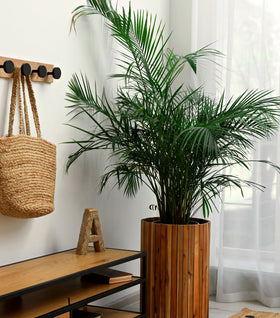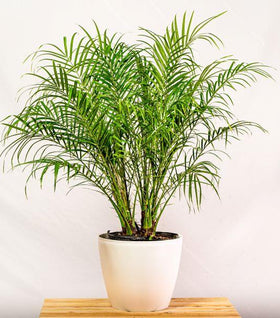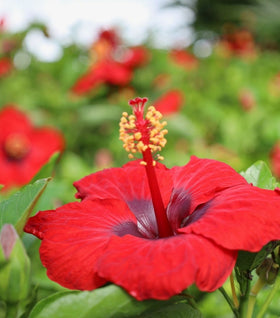Patio Plants for Sale Online
Tropical plants can transform your patio or pool deck into a colorful outdoor living room. For most of us in the United States growing tropical plants outdoors is something we think is only done in the south. Creating a tropical oasis on your deck or patio is easier than you may think. We've curated this plant collection to make it easier for you to choose plants that will turn any outdoor space into a tropical oasis.
Tropical plants are available in a wide range of colors, shapes, and sizes. Palms, for example, are a great choice for adding a laid-back coastal feel to a pool deck, patio, or balcony. Tropical patio plants also make it easy to create an interesting combination in larger containers. In the winter you can leave them outdoors and treat them as annuals and plan to replace them in the spring or early summer, or if you have lots of light in your home, you can overwinter them as house plants and move them outdoors again in the spring.
Types of Patio Plants
Majesty Palm Trees
Majesty palm trees (Ravenea rivularis), also known as a the "Raven palm" are a low maintenance palm houseplant that will add classic looks to your patio plant collection. The Majesty palm prefers moist soil and humid air. When potted, this kingly palm can reach 10 feet in height. But don't worry, it is a slow grower, so it won't get too big, too soon. Majesty Palm Trees are not only beautiful they are hard workers and filter the air.
Croton Petra Plants
Croton Petra plant's (Codiaeum variegatum) brightly colored green, gold, yellow and red foliage give it a tropical look. Easy to grow indoors, Croton Petra can also be moved outside in warmer weather to give your deck or pool that same tropical feel. Crotons also thrive in bright light and prefer to stay moist. Croton plants not only look stunning they are also functional and are capable of cleaning the air.
Pink Tropical Hibiscus Bush
Pink Tropical Hibiscus Bush (Hibiscus rosa-sinensis) is a tropical patio plant known for its stunning bright pink blossoms which begin in early summer through the fall. Thriving in tropical climates and full to partial sun, this pink beauty will be right at home on your patio, screened-in porch, or pool deck this summer. Pink Hibiscus plants can grow up to 8 feet tall and span 3 feet wide in their natural environment.
Pink Tropical Hibiscus also attracts hummingbirds, butterflies, and other pollinators adding even more color to your world during the summer months.
When you buy your Pink Tropical Hibiscus Bush online, put it outside in the summertime and watch it thrive. In the winter, you can bring your hibiscus inside but since it prefers hot, moist climates, it tends not to bloom indoors.
Red Tropical Hibiscus Bush
Red Tropical Hibiscus (Hibiscus rosa-sinensis) is a tropical patio plant that is known for its intense red blooms. Preferring partial to full sun, it will be right at home on your sunny patio, screened-in porch, or pool deck. Red Hibiscus plants can also grow up to 8 feet tall and can span 3 feet in diameter in their natural environment.
When you buy your Red Tropical Hibiscus Bush online, put it outside in the summertime and watch it thrive. In the winter, you can bring your hibiscus inside where it prefers hot, moist climates. Although it tends to not bloom indoors it will still be an attractive house plant until it blossoms again in the summer.
Cordyline Red Sister Plants
Cordyline Red Sister (Cordyline Fruticosa) or "Red Sister", also known as Ti Plants, are a tropical house plant with intensely vibrant fuchsia and dark magenta foliage. Low maintenance and easy to grow, the "Red Sister" is a perfect house plant for first-timer growers.
Cordyline prefers medium to bright indirect light, so a semi-shaded section of your patio would be an ideal location to enjoy this fiery beauty.
6 TIPS FOR PATIO GARDEN CARE
-
Adequate Drainage: It seems obvious, but a pot or planter’s drainage capacity is an easy thing to overlook. Especially since when you purchase a plant container you most likely assume that the drainage holes are more than adequate for the size of the container and the plant that it would house. For any plant to survive and thrive, it is vital that it has the proper amount of drainage. If there isn't adequate drainage, soil can become saturated which can cause the root system to rot. This will inevitably cause your plant to die. Although some containers' drainage capacity can be increased with a drill or other tool, it is not advised and could cause the container to crack depending on how it is constructed, or worse, personal injury. It is much easier, and safer, to simply shop for containers that have enough drainage holes to begin with.
The inclusion of a saucer under the planter is an ideal design for optimal drainage and proper air flow. The Quadra Trio 3.5 inch square planter set by EcoForms has all of these features and is a great choice for your smaller patio plants. Another great choice is the 12 Inch Round Planter by Crescent Gardens which is a resin planter. Being constructed of resin it is light weight, able to insulate the soil protecting your patio plants from extreme heat and cold.
MYTH: Adding gravel or other material to the bottom of a pot will help increase drainage. Adding material to a planter, pot, or other container housing a plant will not increase drainage and could potentially cause the plant to not thrive and ultimately die. The main reason for this is the saturation of the root system which inevitably will lead to rot.
-
Adequate Light: We all know plants need light, but it can be essential to match a plant’s required sun exposure with its location in your garden. Light is key to photosynthesis, which is the process of light energy converting carbon dioxide and water into carbohydrates, which the plant then uses for food and nutrition. Photosynthesis can also take place using artificial light as well as natural sunlight, and many plants can, and do, thrive indoors this way.
So, since light is the catalyst for photosynthesis, it will be important to determine the amount and intensity of sunlight for any location you are considering.
- Adequate water: It probably goes without stating, but just like soil and light, water is essential to your plants' growth and health. The adequate amount of water for any particular plant to thrive depends on several factors. Water is essential to the germination of seeds and It is also required for photosynthesis to occur. And ultimately, it helps the plant process minerals and nutrients from the soil.
- The Correct Soil: Choosing the correct soil for a plant to grow and thrive is also an essential part of plant care. Soil from yards should not be used to pot your patio plants. Transferring used soil can introduce insects, bacteria, and weeds to your newly potted leafy friends. This can compromise the plants’ health and possibly even kill them. Although pre-packed potting soil mix can be adequate, it usually doesn't contain any of the same helpful nutrients found in dedicated plant fertilizers. Most plants will need fertilizer added to their soil in order to thrive. Jack's Classic Houseplant Special Fertilizer is a perfect choice for any house plant since it keeps the nutrition levels constant which prevents nutrient stress caused by over or underfeeding.
-
Living in Harmony: Where your plants are situated in reference to one another is an important consideration, especially if you are planting them in the same plot, container, or planter. Nature has a way of sorting out where plants live and which plants they live next to. But, when you create a home garden, it is up to you to create a harmonious environment for all of your different plants to live together. It may be obvious, but placing plants together with differing light and watering needs will undoubtedly cause some of them to suffer and not thrive.
For instance, Cordyline Red Sister plants thrive in medium indirect light like that provided by a semi-shaded patio area. A Croton Petra plant, which thrives in bright, direct light next to the Red Sister, placed in this same area may look complimentary for both plants, but will not provide the Croton the sunlight it requires. Because of this, the Croton will suffer and most likely not thrive and possibly not survive.
-
Know your Zone: A hardiness zone is a geographic area which is defined to encompass a certain range of climatic conditions relevant to plant survival and growth. This system of “hardiness zones” was developed by the U.S Department of Agriculture (USDA) as a general guide for gardening. There are 13 grow zones in all.
As a gardener, your knowledge and understanding of which “hardiness zone” corresponds to your planting location whether it is a garden, yard, patio, or deck is one of your greatest tools. The zones and their geographic location will affect the vitality of your plants and how they will grow. Knowing your "zone" can help you determine which plants will be ideal for your garden. FIND YOUR ZONE HERE





















